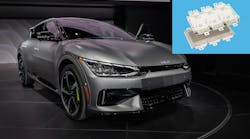Adoption of silicon carbide (SiC) is becoming more widespread among electric-vehicle (EV) systems such as dc-dc converters, traction inverters, and on-board chargers (OBCs) with bidirectional operation available for vehicle-to-grid power transfer.
Compared to conventional silicon power semiconductors, smaller SiC devices can handle higher operating voltages that allow for faster charging and improved vehicle dynamics. They also increase energy efficiency, which boosts driving range and improves reliability.
STMicroelectronics introduced its first SiC diodes in 2004. SiC MOSFETs were introduced by the company in 2009 and entered mass production in 2014. The company has already supplied STPOWER SiC devices for more than three million mass-produced passenger cars worldwide.
ST now has followed up with the release of high-power modules for EVs that improve performance and driving range. The five new SiC-MOSFET based power modules provide flexible choices for automakers, covering a selection of power ratings and support for operating voltages commonly used in EV traction applications.
“ST silicon-carbide solutions are enabling major automotive OEMs to set the pace of electrification when developing future generations of EVs,” said Marco Monti, President, Automotive and Discrete Group, STMicroelectronics. “Our third-generation SiC technology ensures the greatest power density and energy efficiency, resulting in superior vehicle performance, range, and charge time.”
Hyundai Opts for ACEPACK
Hyundai Motor Group has chosen ST’s ACEPACK DRIVE SiC-MOSFET Gen3-based power modules for its current-generation EV platform, called E-GMP. In particular, the modules will power the Kia EV6.
“ST’s SiC-MOSFET-based power modules are the right choice for our traction inverters, enabling longer range,” said Sang-Cheol Shin, member of the Inverter Engineering Design Team at Hyundai Motor Group.
Housed in ST’s ACEPACK DRIVE package, a six-pack configuration optimized for traction applications, the modules are suitable for high-volume production, providing direct liquid-cooling capability and high-power density at the same time. A copper baseplate with pin-fin base structure makes direct fluid cooling possible, minimizing thermal resistance. It’s the first direct liquid-cooled solution available in ST’s portfolio.
Internally, the main power semiconductors are ST’s third-generation (Gen3) STPOWER SiC MOSFETs, which combine what’s claimed to be an industry-leading figure of merit (RDS(ON) × die area) with limited switching losses (a dedicated pinout has been developed) and what’s said to be superior performance in synchronous-rectification working mode. This will save battery recharging cycles.
ST’s 1200V ADP280120W3, ADP360120W3, and ADP480120W3 are in full production. The 750-V ACEPACK DRIVE ADP46075W3 and ADP61075W3 will be in full production by March 2023. They enable a plug-and-play solution for traction inverters compatible with direct liquid cooling.
Press-Fit Pins
For the ACEPACK DRIVE power module, press-fit pins ensure optimal contact between the module and the driving board. The press-fit pin was selected as it’s the kind of connection known for reliability.
The electrical and thermal contacts with the circuit board are implemented by means of cold welding when using press-fit pins. Permanent deformation takes place because of PCB insertion; this deformation provides the basis for the cold welding. A module that’s been pressed in and then pressed out can’t be pressed in again since plastic deformation of the press-fit zone doesn’t permit further press-fit processes.
Press-fit contact isn’t sensitive to oxidation and corrosion or vibration, and it realizes a gas-tight connection with PCB dedicated holes. Since no preconditioning or heating is needed for the assembly, the assembly process is reliable and easily industrialized. The resulting forces during the press-fit process ensure that the welded materials onto the PCB and pin exhibit a continuously consistent and, unlike other contact technologies, very small electrical contact resistance
The power module’s SiC-based features include a symmetrical pinout between high- and low-side switches. To avoid any possible mistake during the assembly phase as well as speed up the process, the X-pin and Y-pin employ a poka-yoke concept (poka-yoke is a Japanese term that means “mistake-proofing,” and refers to any tool or mechanism that keeps one from being able to perform an action in an incorrect manner). The X-pin (smaller) and Y-pin (larger) show different dimensions that allow for a properly designed PCB a single possible path to the press-fits.
ACEPACK DRIVE is a plug-and-play power module. The module must be properly connected with the drive components and the cooling system in order to work and to avoid any mechanical stress to the sensitive components. Hence, ST recommends following this sequence when assembling the power module:
- Align driving board PCB to power module. X-pins with the poka-yoke ensure the proper alignment.
- Press-in driving board through a mechanical press and a JIG designed on the power module.
- Prepare water jacket with sealing ring.
- Position and screw the preassembled power module and driving board in the water jacket.
- Screw the driving board to the power-module case.
Conclusion
Summing up, Hyundai Motor Company has chosen ST’s ACEPACK DRIVE power modules for its E-GMP vehicle platform. ACEPACK DRIVE is a compact power module tailored for hybrid and EV traction applications, capable of satisfying the growing demand by automakers for greater power and efficiency solutions. The third-generation SiC MOSFET technology combined with ACEPACK DRIVE modules results in increased efficiency, maximizes EV mileage range, as well as enables the usage of smaller battery packs.
